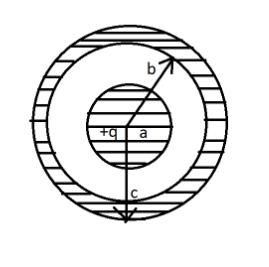
A non-conducting sphere of radius $ A $ has net charge $ + q $ uniformly distributed throughout in volume. A hollow spherical conductor having inner and outer, radii ' $ b $ ' and ' $ c $ ' and net charge ' $ - q $ ' is concentric with the sphere (see the figure) Read the following statements:

(i) The electric field at a distance $ {{r}} $ from the centre of the sphere $ = \dfrac{1}{{4\pi {\varepsilon _0}}}\dfrac{{{{qr}}}}{{{{{a}}^3}}} $ for $ {{r}} < {{a}} $
(ii) The electric field at distance $ {{r}} $ from the centre of the sphere for $ {{a}} < {{r}} < {{b}} = 0 $
(iii) The electric field at distance $ {{r}} $ from the centre of the sphere for $ {{b}} < {{r}} < {{c}} = 0 $
(iv) The charge on the inner surface of the hollow sphere $ = - {{q}} $
(v) The charge on the outer surface of the hollow sphere $ = + {{q}} $
Which of the above statements are true?
(A) (i.), (ii.) and (v.)
(B) (i.), (iii.) and (iv.)
(C) (ii.), (iii.), and (iv).
(D) (ii.), (iii.), and (v.)

Answer
544.2k+ views
Hint: It is possible to consider the electric field as an electrical property associated with each point in the space where a charge is present in any form. The electric force per unit charge is also described as an electric field.
Complete Step-by-Step Solution
Let $ {{{q}}^1} $ is the inner surface charge.
Then, $ {q_{outer}} = - q - {q^1} $
$ {{{q}}_{{{inside}}}}{{ + }}{{{q}}_{{{outside}}}} = - q $
Electric field inside
The conductor should be zero $ (r > b $ and $ r < e) $ so in the arbitrary Gaussian surface
Electric flux $ = \dfrac{{{{ }}{{{q}}_{{{inside}}}}{{ }}}}{{{\varepsilon _0}}} = 0 $
$ \Rightarrow $ $ {{ }}{{{q}}_{{{inside}}}} $ $ ({{b}} < {{r}} < {{c}}) = {{{q}}^1} + {{q}} = 0 $
$ {{{q}}^1} = - {{q}} $
So, $ {{ }}{{{q}}_{{{inside}}}} $ $ = - {{q}} $ and $ {{{q}}_{{{outer }}}} = 0 $
Electric field for $ r < a $ is,
$ {{E}} \times 4\pi {{{r}}^2} = \dfrac{{{{ }}{{{q}}_{{{inside}}}}{{ }}}}{{{\varepsilon _0}}} $
As a charge is uniformly distributed $ q $ inside $ = \left( {\dfrac{{{r^3}}}{{{a^3}}}} \right)q $
So, $ {{E}} \times 4\pi {{{r}}^2} = \dfrac{{{{{r}}^3}{{q}}}}{{{{{a}}^3}{\varepsilon _0}}} $
$ \Rightarrow {{E}} = \dfrac{1}{{4\pi }} \times \dfrac{{{q}}}{{{{{a}}^3}{\varepsilon _0}}} $
Now, electric field for $ {{a}} < {{r}} < {{b}} $ ,
$ {{E}} = \dfrac{{{{kq}}}}{{{{{r}}^2}}} $
Now, the electric field for $ {{b}} < {{r}} < {{c}} $
As told earlier, $ {{E}} = {{O}} $
Now, the electric field for $ {{c}} < {{r}} $
$ {{E}} = \dfrac{{{{{k}}_{{{quotes}}}}}}{{{{{r}}^2}}} = {{k}}\dfrac{{{{(0)}^2}}}{{{{{r}}^2}}} = 0 $
Hence, the correct option is (C).
Note
Mathematically, the electric field is defined as a vector field that can be associated with each point in space, at which point the force per unit charge is exerted on a positive test charge at rest. The electric field is generated by electric charges or by magnetic fields that vary in time. The electric field is responsible for the attractive forces between the atomic nucleus and the electrons that then hold together in the case of the atomic scale.
Complete Step-by-Step Solution
Let $ {{{q}}^1} $ is the inner surface charge.
Then, $ {q_{outer}} = - q - {q^1} $
$ {{{q}}_{{{inside}}}}{{ + }}{{{q}}_{{{outside}}}} = - q $
Electric field inside
The conductor should be zero $ (r > b $ and $ r < e) $ so in the arbitrary Gaussian surface
Electric flux $ = \dfrac{{{{ }}{{{q}}_{{{inside}}}}{{ }}}}{{{\varepsilon _0}}} = 0 $
$ \Rightarrow $ $ {{ }}{{{q}}_{{{inside}}}} $ $ ({{b}} < {{r}} < {{c}}) = {{{q}}^1} + {{q}} = 0 $
$ {{{q}}^1} = - {{q}} $
So, $ {{ }}{{{q}}_{{{inside}}}} $ $ = - {{q}} $ and $ {{{q}}_{{{outer }}}} = 0 $
Electric field for $ r < a $ is,
$ {{E}} \times 4\pi {{{r}}^2} = \dfrac{{{{ }}{{{q}}_{{{inside}}}}{{ }}}}{{{\varepsilon _0}}} $
As a charge is uniformly distributed $ q $ inside $ = \left( {\dfrac{{{r^3}}}{{{a^3}}}} \right)q $
So, $ {{E}} \times 4\pi {{{r}}^2} = \dfrac{{{{{r}}^3}{{q}}}}{{{{{a}}^3}{\varepsilon _0}}} $
$ \Rightarrow {{E}} = \dfrac{1}{{4\pi }} \times \dfrac{{{q}}}{{{{{a}}^3}{\varepsilon _0}}} $
Now, electric field for $ {{a}} < {{r}} < {{b}} $ ,
$ {{E}} = \dfrac{{{{kq}}}}{{{{{r}}^2}}} $
Now, the electric field for $ {{b}} < {{r}} < {{c}} $
As told earlier, $ {{E}} = {{O}} $
Now, the electric field for $ {{c}} < {{r}} $
$ {{E}} = \dfrac{{{{{k}}_{{{quotes}}}}}}{{{{{r}}^2}}} = {{k}}\dfrac{{{{(0)}^2}}}{{{{{r}}^2}}} = 0 $
Hence, the correct option is (C).
Note
Mathematically, the electric field is defined as a vector field that can be associated with each point in space, at which point the force per unit charge is exerted on a positive test charge at rest. The electric field is generated by electric charges or by magnetic fields that vary in time. The electric field is responsible for the attractive forces between the atomic nucleus and the electrons that then hold together in the case of the atomic scale.
Recently Updated Pages
Master Class 12 Economics: Engaging Questions & Answers for Success

Master Class 12 Maths: Engaging Questions & Answers for Success

Master Class 12 Biology: Engaging Questions & Answers for Success

Master Class 12 Physics: Engaging Questions & Answers for Success

Basicity of sulphurous acid and sulphuric acid are

Master Class 12 Business Studies: Engaging Questions & Answers for Success

Trending doubts
What are the major means of transport Explain each class 12 social science CBSE

Which are the Top 10 Largest Countries of the World?

Draw a labelled sketch of the human eye class 12 physics CBSE

How much time does it take to bleed after eating p class 12 biology CBSE

Explain sex determination in humans with line diag class 12 biology CBSE

Differentiate between homogeneous and heterogeneous class 12 chemistry CBSE




